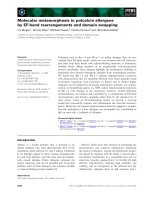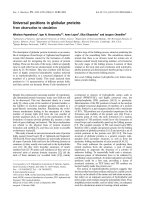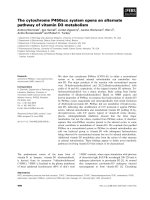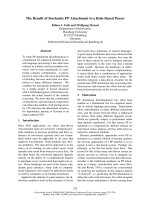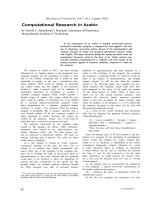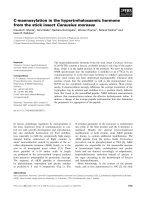báo cáo khoa học: " Translating research in elder care: an introduction to a study protocol series" doc
Bạn đang xem bản rút gọn của tài liệu. Xem và tải ngay bản đầy đủ của tài liệu tại đây (739.03 KB, 8 trang )
BioMed Central
Page 1 of 8
(page number not for citation purposes)
Implementation Science
Open Access
Study protocol
Translating research in elder care: an introduction to a study
protocol series
Carole A Estabrooks*
1
, Alison M Hutchinson
1
, Janet E Squires
1
,
Judy Birdsell
2
, Greta G Cummings
1
, Lesley Degner
3
, Debra Morgan
4
and
Peter G Norton
5
Address:
1
Faculty of Nursing, University of Alberta, Edmonton, Alberta, Canada,
2
Haskayne School of Business, University of Calgary, Calgary,
Alberta, Canada,
3
Faculty of Nursing, University of Manitoba, Winnipeg, Manitoba, Canada,
4
Canadian Centre for Health and Safety in Agriculture
(CCHSA), University of Saskatchewan, Saskatoon, Canada and
5
Faculty of Medicine, University of Calgary, Calgary, Alberta, Canada
Email: Carole A Estabrooks* - ; Alison M Hutchinson - ;
Janet E Squires - ; Judy Birdsell - ; Greta G Cummings - ;
Lesley Degner - ; Debra Morgan - ; Peter G Norton -
* Corresponding author
Abstract
Background: The knowledge translation field is undermined by two interrelated gaps –
underdevelopment of the science and limited use of research in health services and health systems
decision making. The importance of context in theory development and successful translation of
knowledge has been identified in past research. Additionally, examination of knowledge translation
in the long-term care (LTC) sector has been seriously neglected, despite the fact that aging is
increasingly identified as a priority area in health and health services research.
Aims: The aims of this study are: to build knowledge translation theory about the role of
organizational context in influencing knowledge use in LTC settings and among regulated and
unregulated caregivers, to pilot knowledge translation interventions, and to contribute to enhanced
use of new knowledge in LTC.
Design: This is a multi-level and longitudinal program of research comprising two main
interrelated projects and a series of pilot studies. An integrated mixed method design will be used,
including sequential and simultaneous phases to enable the projects to complement and inform one
another. Inferences drawn from the quantitative and qualitative analyses will be merged to create
meta-inferences.
Outcomes: Outcomes will include contributions to (knowledge translation) theory development,
progress toward resolution of major conceptual issues in the field, progress toward resolution of
methodological problems in the field, and advances in the design of effective knowledge translation
strategies. Importantly, a better understanding of the contextual influences on knowledge use in
LTC will contribute to improving outcomes for residents and providers in LTC settings.
Published: 10 August 2009
Implementation Science 2009, 4:51 doi:10.1186/1748-5908-4-51
Received: 24 April 2009
Accepted: 10 August 2009
This article is available from: />© 2009 Estabrooks et al; licensee BioMed Central Ltd.
This is an Open Access article distributed under the terms of the Creative Commons Attribution License ( />),
which permits unrestricted use, distribution, and reproduction in any medium, provided the original work is properly cited.
Implementation Science 2009, 4:51 />Page 2 of 8
(page number not for citation purposes)
Introduction
In this issue of Implementation Science we present study
protocols for the Translating Research in Elder Care
(TREC) program of research. We include an overview of
the program (this paper), as well as protocols for the two
major interrelated projects within the TREC program
which were launched in 2008 and 2009 [1,2].
Program description
The TREC research program described here is the second
phase (2007 to 2012) of a long-term investigation into
the determinants and processes of using research knowl-
edge to improve care and management in healthcare
organizations. The purpose of this program is to develop
a robust theoretical understanding of knowledge transla-
tion in action in order to facilitate changes that result in
better outcomes for recipients of healthcare. The purpose
of the present five-year phase of the program is to address
the impact of organizational context (i.e., organizational
setting and environmental factors) on knowledge transla-
tion, and the subsequent impact of knowledge translation
on resident health outcomes (and secondarily on provider
and system outcomes) in long-term care (LTC) facilities
(nursing homes) in Canada's three Prairie Provinces. In
this protocol series, we primarily use the term 'knowledge
translation'. While we are aware of important differences
in meaning between terms and of significant terminology
confusion in the field [3,4], we use the terms knowledge
translation, knowledge utilization, research implementa-
tion, and research utilization synonymously in this proto-
col series.
Program aims
The TREC program is guided by three objectives:
1. To contribute to the development of empirically based
knowledge translation theory by examining the role of
organizational context in influencing knowledge use in
LTC settings, and among regulated and unregulated car-
egivers. This will be accomplished by:
a. Developing and implementing an organizational
monitoring system to profile context in LTC facilities
b. Collecting in-depth organizational data including
process changes over time
2. To pilot innovative knowledge translation interven-
tions
3. To enhance use of new knowledge in LTC
Secondary objectives of the TREC program are:
1. To develop research capacity through the training of
graduate students and postdoctoral fellows
2. To cultivate a community of decision makers in LTC in
the Canadian Prairie Provinces with an interest in enhanc-
ing the use of research findings to improve resident care
3. To define ongoing objectives for the next phase of the
program
The present TREC Program is multi-disciplinary, multi-
level (provinces, regions, facilities, units within facilities,
individuals) and longitudinal (five year), and is com-
prised of two main interrelated projects and a series of
pilot studies. The pilot studies involve developing and
assessing the feasibility of knowledge translation inter-
ventions in the areas of: strategic storytelling, supportive
supervision, and leadership development. The two major
projects are:
1. Project one: Building context, an organizational moni-
toring system in LTC.
2. Project two: Building context, a case study program in
LTC.
Project one: Building context – an organizational
monitoring system in LTC
This project will monitor and explore organizational con-
text over the five years in 36 nursing homes in the Cana-
dian provinces of Alberta, Saskatchewan, and Manitoba.
Structural facility and unit-level data will be collected
through short structured interviews. In addition, unregu-
lated (i.e., healthcare aides), regulated (i.e., nurses, physi-
cians, allied health, educators/specialists) care providers
together with managers in each facility will be asked to
complete the TREC survey, a suite of instruments designed
to measure organizational context and its impact on
knowledge translation (three times). Data on resident
outcomes will be derived from administrative data rou-
tinely collected with the Resident Assessment Instrument/
Minimum Data Set – Version 2.0 (RAI-MDS 2.0).
Project two: Building context – a case study program in
LTC
This project will use an in-depth case study approach to
explore the role of organizational context in promoting
knowledge translation. The project will begin with com-
prehensive case studies in three facilities and then under-
take focused case studies in six additional facilities. The
facilities to be studied are all enrolled in project one. The
data will be obtained through direct observation, inter-
views with stakeholders (care providers, provincial health
leaders, managers, family members and external commu-
nity representatives) and document analysis.
Implementation Science 2009, 4:51 />Page 3 of 8
(page number not for citation purposes)
The purpose of this paper is to provide an overview of the
TREC program at large, describing aspects of the program
that are common across projects one and two, details of
which are provided in the accompanying protocols [1,2].
Background
There are two significant and interrelated gaps in the
knowledge translation field. First, the science is seriously
underdeveloped. Second, the use of research in health
services and health systems decision making remains low,
despite increased accessibility and awareness on the part
of clinicians and decision makers [5-10]. These gaps have
resulted in a renewed examination of the assumptions
underpinning the knowledge translation paradigm. Gla-
ser et al.'s encyclopaedic review of the literature on the
topic [11], as well as more recent reviews [12-17], have
identified major conceptual and methodological issues
facing investigators in the field today. Those pertinent to
the TREC program include:
1. Inadequate conceptualizations of knowledge transla-
tion, and a lack of testable knowledge translation theory
(what we would term mid-range theory)
2. Over-reliance on rational actor explanatory models,
and a related need to use models that focus more on
organizational issues, interaction, and linkage
3. Inadequate measurement of knowledge translation,
either as a dependent or independent variable
4. Lack of causal analyses
5. Over-examination of knowledge translation as product,
rather than process
6. Need for inclusion of variables related to social and
relational capital, and linkage mechanisms
7. Fragmentation in the knowledge translation field, and
an attendant need for programmatic investigations and
integration of disciplines
Findings from the first five-year phase of our program [18-
22] and work by others [23-27] point to the central
importance of organizational context in both theory
development and successful research implementation. In
the TREC program we propose to expand on this knowl-
edge base by examining knowledge translation in the LTC
sector. As in many countries, Canada has been imple-
menting the RAI-MDS 2.0 in this sector. This implemen-
tation in LTC is sufficiently advanced to allow us to access
data on resident outcomes [28-30].
Sector definitions
Long-Term Care: In Canada we have many terms for set-
tings providing facility-based care for the elderly [31]. In
TREC, we are focusing on facility-based settings where res-
idents live permanently with round-the-clock housekeep-
ing, personal, and healthcare services. Whether public,
voluntary, or private, we describe all of these facilities as
LTC settings or nursing homes.
Workers in LTC: The care delivered to residents of nursing
homes is provided largely by unregulated workers. For
example, 70% of direct-care staff in Alberta nursing
homes are healthcare aides (sometimes called personal or
resident care aides), "an unregulated group of workers
trained on the job, and students and graduates of PCA cer-
tification programs at colleges and vocational schools,
which vary from 12 to 40 weeks" [[32], p. 23]. Another
13% are licensed practical nurses (LPNs) while only 17%
are registered nurses (RNs).
Why are we studying LTC?
There is a significant burden at the present time that will
increase in the near future. In 2006, 13.7% of the Cana-
dian population was over 65 years of age [33]; this pro-
portion is expected to rise to 14.4% by 2011 and nearly
23.4% by 2031 [34]. This represents a dramatic demo-
graphic shift with consequences for all aspects of individ-
ual, community, and national life. Increasingly, we see
calls for aging as a priority area in Canadian health
research [35,36].
Who lives in LTC – chronicity, frailty, vulnerability
The proportion of older Canadians who live in LTC facil-
ities has remained stable at about 4.5% over the last two
decades, and as the number of older adults in the popula-
tion rises, so does the number of older adults in LTC
[37,38]. Some have estimated that 43% of Canadian sen-
iors will live three to four years in a LTC facility, and that
one in five will live there more than five years [39,40].
Over one-third (37.6%) of Canadians in LTC facilities are
the frail elderly over 85 years of age [41]. These residents
are highly vulnerable with complex needs in all spheres
and high dependency on their providers.
Quality of care
Several reports at the international [42], national [43],
and provincial levels [32,44] describe the suboptimal
quality of care in LTC settings. In order to improve health-
related quality of life and care of older Canadians who
reside in LTC, it will be necessary to, among other things,
efficiently and effectively translate research findings into
better care provision, facility management, and policy
making. Such translation will only occur at the provider
level if those providers have both the knowledge and the
capacity to use it, as well as the appropriate structural and
Implementation Science 2009, 4:51 />Page 4 of 8
(page number not for citation purposes)
system supports. In Canada, the training of providers in
seniors' care is regarded as deficient [35]. The fact that care
is largely provided by unregulated caregivers affects both
the ability to apply new knowledge in practice and the
quality of services offered to seniors. Better knowledge
translation among all LTC providers, regulated and unreg-
ulated, in nursing homes is one important way to improve
the quality of care received by seniors.
Research considerations in relation to the LTC sector
LTC facilities have several features which make them suit-
able environments for studying knowledge translation.
First, the facilities have sufficient but not excessive varia-
tion in critical variables, such as resident population, size,
funding models, and the like across the Prairie Provinces.
Second, the workforce includes both regulated and unreg-
ulated caregivers. Little attention has been paid to knowl-
edge translation in the latter group. Third, the
implementation of the RAI MDS-2.0 system is sufficiently
advanced in the prairies to allow us stable outcome assess-
ments at the resident level. Fourth, little knowledge trans-
lation work has been undertaken in these settings, and
systematic efforts to improve quality of care lag behind
those in acute and primary care. Balanced against this is a
serious lack of resources in this sector, suggesting an
urgent need for innovative interventions, designed to
maximize impact and minimize resource demands. These
features create a valuable natural laboratory within which
to study important contextual differences and develop
innovative strategies to improve knowledge translation.
Data management
Data will be collected in a variety of forms during the
course of the TREC research program. Data collected dur-
ing project one will be generated from web-based surveys
(regulated care providers and managers) and computer-
assisted personal interviews (CAPI) for unregulated care
providers. Facility- and unit-level data will be collected in
structured interview format using standardized forms.
Resident data will be obtained from the custodians of the
routinely collected RAI-MDS 2.0. Project two data will be
collected using non-participant observation, focus groups,
one-to-one interviews, family diaries, facility and unit
documents, and photographs of relevant artefacts and/or
non-resident care activities. Details of the data types and
the collection methods used in both projects one and two
are contained in the respective protocols [1,2]. Protocols
for the management and storage of the various forms of
data have been developed.
All data will be stored on secure servers at the University
of Alberta and will be managed centrally in accordance
with agreed to Canadian Tri-Council standards [45]. Data
quality will be ensured through standard quality control
methods. Explicit procedures for checking the data for
quality have been developed and are executed on a rou-
tine basis, and deviations from expected quality are inves-
tigated using defined processes. Final master and index
files are designated from which all analyses will be con-
ducted. A TREC-specific data unit has been established
and is currently staffed by two data analysts, a data man-
ager, and two trainees. Members of the data unit receive
their overall direction from the principal investigator and
the Data Management Committee of TREC. The TREC
data manager is responsible for the secure transfer of all
data from the website to the central study server at the
University of Alberta. We will preserve full anonymized
records of all data from the TREC research program, in
accordance with CIHR's open access policy [46], indefi-
nitely for ongoing analysis.
Mixed method analysis
The TREC program draws on multiple sources of data and
is based on a fully integrated mixed method design (see
Figure 1) that aims to address multiple questions using
quantitative (project one) and qualitative (project two)
data collection and analysis methods. The broken lines in
Figure 1 represent the effects of data analysis and inference
development on subsequent cycles of sampling, data col-
lection, and analysis.
The two major TREC projects are designed to complement
and inform one another. Inferences will be drawn from
results of the complementary qualitative and quantitative
analyses and will subsequently be merged to create meta-
inferences [47]. The program design includes sequential
and simultaneous phases, thereby enabling the different
projects and phases to inform or result in modification of
parallel and sequential elements of the research program.
The use of mixed methods will enable efficient conver-
gence on better understanding and ultimately richer the-
ory development. Members of the project teams will shift
back and forth between the quantitative and qualitative
data to ensure that a robust explanation of organizational
context is achieved. This will be an iterative process
whereby each project can probe subsequent data collec-
tion waves of each other. For example, if the concept of
organizational slack (a core dimension assessed in the
TREC survey) is shown to be an important part of organi-
zational context in project one, but has not surfaced in
project two; by feeding this information to the investiga-
tors of project two, they can not only probe for it but also
explore more deeply why it may be important.
The value added in this program of research comes from
our ability to integrate data and analyses from multiple
sources using multiple methods. The primary reason for
using mixed methods is to allow us to converge on organ-
izational context, and thus advance theory that maps
Implementation Science 2009, 4:51 />Page 5 of 8
(page number not for citation purposes)
TREC mixed method study designFigure 1
TREC mixed method study design. (after Tashakkori and Teddlie, 2003[47]). This Figure shows the integration of TREC
projects one and two.
Implementation Science 2009, 4:51 />Page 6 of 8
(page number not for citation purposes)
organizational context and knowledge translation [47-
51]. We will compare and contrast qualitative and quanti-
tative data about the same phenomenon; emphasizing
how qualitative findings link to and confirm quantitative
findings, as well as how quantitative findings inform
qualitative findings – thereby validating findings and
enhancing generalizability. We have timed data collection
to permit successive iterations so that this is possible.
Additionally, mixed methods assist in elaborating and
clarifying results by capitalizing on method strengths and
reducing potential method biases. This principle also
applies to the examination of different levels of similar
phenomena – as is the case when we undertake multi-
level data collection and modeling. Combining qualita-
tive and quantitative data and using iterative waves of data
collection from multiple sources over time will provide a
more complete view of organizational context.
Ethical Approval
Ethics approvals for the two TREC main projects have
been received from the appropriate university ethics
boards: Universities of Alberta (#B-051007, #B-061007),
Calgary (#E21379), Manitoba (#E200:010, #E200:011),
Saskatchewan (BEH#08-165, 08-17), and Regina
(REB#08-81).
Return on research investment
A focus on how the results of research projects will return
on the initial investment of research dollars is increasingly
expected in research programs. Often this is understood as
knowledge translation or integrated knowledge transla-
tion. We anticipate return will come in two main areas –
the research community and the LTC sector. As such, we
are engaged in both mode one (traditional scholarly activ-
ities) and mode two (partnerships with policy- and deci-
sion-makers) mechanisms of knowledge production and
translation [52].
Traditional scholarly activities will include presentations
at scientific conferences and publications in peer-
reviewed journals, and will also occur through active par-
ticipation of investigators on research and/or policy com-
mittees and groups in relevant areas.
Return on investment in the LTC sector relates to enabling
timely use of relevant research findings in the LTC sector.
The objectives of TREC in relation to return on investment
in the LTC sector are:
1. To ensure that facilities participating in the research
learn from the research undertaken in their facility in ways
that are meaningful to them
2. To establish processes where all facilities within the
organizations supporting TREC research (and eventually
facilities in the Prairie Provinces) learn from research
undertaken within TREC in ways meaningful to them
3. To contribute to creating sustainable enhanced capacity
within the LTC sector to provide excellent care and sup-
port informed by research evidence
Our work has a horizon that extends beyond the five years
of this study and beyond the designated study sites. This
long-term endeavour will be done in collaboration with
the sector; TREC can be considered one catalyst for a larger
vision related to system improvements. In the short term,
we will focus on the study facilities, with a view to ena-
bling enhanced research use in facilities in the three
involved provinces. Mechanisms to work toward this
vision include:
1. Engagement with decision makers: Decision makers
from the three Prairie Provinces are involved as partners in
TREC. They participate actively in planning and strategic
sessions. Strategies are also being developed in collabora-
tion with the sector to get direct input from frontline staff.
2. Timely sharing of research results in ways that are useful
to staff in the LTC sector: Working with our sector part-
ners, feedback and results from the research program are
being shared in a regular and ongoing manner and in
mutually agreed ways (e.g., in-person, in brief written
form, using posters) with both site administrators and
frontline staff.
3. Collaboration with organizations with a mandate or
interest in enhancing research use capacity: Participating
in one research program will not ensure ongoing capacity
enhancement. Discussions are ongoing with organiza-
tions that are interested in collaborating to build sustain-
able capacity to use research findings in the LTC sector
(e.g., Health Quality Councils of Alberta and Saskatch-
ewan, Health Canada).
4. Strategic dissemination: This will include dissemina-
tion of 'plain language' results and other information rel-
evant to policy makers and organizations that influence
care of the elderly. Strategic dissemination will be planned
by the research team and sector partners, jointly.
Capacity building
We have an opportunity to build research capacity in both
the knowledge translation and LTC fields by providing an
enriched training environment. Several trainees at both
the doctoral and post-doctoral levels are currently
engaged in the research program, and other trainees will
be recruited throughout the duration of the program.
Implementation Science 2009, 4:51 />Page 7 of 8
(page number not for citation purposes)
When feasible, they will be actively involved in aspects of
the program beyond their own work, such as project
administration and interaction with decision makers.
Conclusion
The products resulting from the various projects described
here will contribute to: integration and theory develop-
ment across disciplines; identifying and resolving major
conceptual problems in the field, similar to Van de Ven's
work [53] in innovation; resolving major methodological
problems in the field; and advances in how to design
effective knowledge translation strategies for the burgeon-
ing group of unregulated individuals caring for seniors in
LTC. The TREC program is about advancing understand-
ing of how organizational context affects knowledge
translation. We have chosen to do this in LTC because it
presents a unique laboratory for study in knowledge trans-
lation. Nursing homes are also places in which some of
Canada's most vulnerable citizens live and in which
health system improvements are urgently needed.
Competing interests
The authors declare that they have no competing interests.
Authors' contributions
CAE is the principal investigator for the TREC research
program. She conceived the program and its design,
secured its funding, is providing the leadership and coor-
dination for the program, and provided substantial com-
mentary to the final submitted manuscript. AMH and JES
are trainees within the TREC research program and made
significant contributions to drafting the manuscript. DM,
GGC, LD, JMB and PGN participated in designing the
study, securing grant funding, and provided critical com-
mentary to the final submitted manuscript. CAE and PGN
co-lead project one and LD is the lead investigator for
TREC project two. LD, DM, GGC are provincial site leads
for Manitoba, Saskatchewan, and Alberta respectively. All
authors read and approved the final submitted manu-
script.
Acknowledgements
The authors acknowledge the TREC team for its contributions to this
study. Funding is provided by the Canadian Institutes of Health Research
(CIHR) (MOP #53107). Dr Estabrooks is supported by a CIHR Canada
Research Chair in Knowledge Translation. Dr Hutchinson is supported by
CIHR and AHFMR Fellowships. Ms Squires is supported by CIHR, AHFMR,
and Killam Fellowships. Dr. Cummings holds a CIHR New Investigator
award and an Alberta Heritage Foundation for Medical Research (AHFMR)
Population Health Investigator award. Dr Degner holds a Canadian Health
Services Research Foundation (CHSRF)/CIHR Chair. Dr Morgan holds a
Chair in Rural Health Delivery in the Canadian Centre for Health and Safety
in Agriculture (Saskatchewan).
As of March 2009, the TREC Team is comprised of the following investiga-
tors, decision makers, collaborators, and advisors listed here in alphabetical
order: Carole A Estabrooks (PI), Caroline Clark (DM), Greta Cummings
(Co-I), Lesley Degner (Co-I), Sue Dopson (Co-I), Heather Laschinger (Co-
I), Kathy McGilton (Co-I), Debra Morgan (Co-I), Peter Norton (Co-I),
Joanne Profetto-McGrath (Co-I), Jo Rycroft-Malone (Co-I), Verena Menec
(Co-I), Anne Sales (Co-I), Malcolm Smith (Co-I), Norma Stewart (Co-I),
Gary Teare (Co-I), David Hogan (collaborator), Chuck Humphrey (collab-
orator), Michael Leiter (collaborator), Judy Birdsell (advisor), Jack Williams
(special advisor), Dorothy Pringle (scientific advisory committee chair),
Gretta Lynn Ell (DM), Phyllis Hempel (advisor), Lori Lamont (DM), Sue
Neville (DM), Corinne Schalm (DM), Donna Stelmachovich (DM), Juanita
Tremeer (DM), Luana Whitbread (DM). Previous decision makers included
Brenda Huband and Marguerite Rowe.
References
1. Estabrooks CA, Squires JE, Cummings GG, Teare GF, Norton PG:
Study protocol for the Translating Research in Elder Care
(TREC): Building Context – an Organizational Monitoring
Program in Long-Term Care Project (Project 1). Implement
Sci 2009, 4(1):52.
2. Rycroft-Malone J, Dopson S, Degner L, Hutchinson AM, Estabrooks
CA: Study protocol for the Translating Research in Elder
Care (TREC): Building Context Through Case Studies in
Long-Term Care Project (Project 2). Implement Sci 2009,
4(1):53.
3. Larsen JK: Knowledge utilization: What is it? Knowledge: Creation,
Diffusion, Utilization 1980, 1:421-442.
4. Graham ID, Logan J, Harrison MB, Straus SE, Tetroe J, Caswell W,
Robinson N: Lost in knowledge translation: Time for a map? J
Contin Educ Health Prof 2006, 26:13-24.
5. Estabrooks CA: The conceptual structure of research utiliza-
tion. Res Nurs Health 1999, 22:203-216 [er sci-
ence.wiley.com/journal/61004138/abstract?CRETRY=1&SRETRY=0].
6. Parahoo K: Barriers to, and facilitators of, research utilization
among nurses in Northern Ireland. J Adv Nurs 2000, 31:89-98.
7. Parahoo K, Barr O, McCaughan E: Research utilization and atti-
tudes towards research among learning disability nurses in
Northern Ireland. J Adv Nurs 2000, 31:607-613.
8. Rodgers SE: The extent of nursing research utilization in gen-
eral medical and surgical wards. J Adv Nurs 2000, 32:182-193.
9. Gothill M: What do doctors want? Altruism and satisfaction in
general practice. Fam Pract 1998, 15:S36-S39.
10. Mitchell DE, Boyd WL: Knowledge utilization in educational
policy and politics: Conceptualizing and mapping the
domain. Educ Adm Q 1998, 34:126-141.
11. Glaser EM, Abelson HH, Garrison KN: Putting Knowledge to Use: Facil-
itating the Diffusion of Knowledge and the Implementation of Planned
Change San Francisco: Jossey-Bass; 1983.
12. Backer TE: Knowledge utilization: The third wave. Knowledge:
Creation, Diffusion, Utilization 1991, 12:225-240.
13. Dunn WN, Holzner B: Knowledge in society: Anatomy of an
emergent field. Knowledge in Society: The International Journal of
Knowledge Transfer 1988, 1:3-26.
14. Greenhalgh T, Robert G, Macfarlane F, Bate P, Kyriakidou O: Diffu-
sion of innovations in service organizations: Systematic
review and recommendations. Milbank Q 2004, 82:581-629.
15. Landry R, Lamari M, Amara N: Climbing the ladder of research
utilization: Evidence from social science research. Sci Commun
2001, 22:396-422.
16. Rich R, Oh C: The utilization of policy research. In Encyclopedia
of Policy Studies 2nd edition. Edited by: Nagel S. New York: M. Dekker;
1994:69-92.
17. Estabrooks CA: Will evidence-based nursing practice make
practice perfect? Can J Nurs Res 1998, 30:15-36.
18. Wallin L, Estabrooks CA, Midodzi WK, Cummings GG: Develop-
ment and validation of a derived measure of research utiliza-
tion by nurses. Nurs Res 2006, 55:149-160.
19. Cummings GG, Estabrooks CA, Midodzi WK, Wallin L, Hayduk L:
Influence of organizational characteristics and context on
research utilization. Nurs Res 2007, 56:S24-39.
20. Estabrooks CA, Midodzi WK, Cummings GG, Wallin L: Predicting
research use in nursing organizations: A multilevel analysis.
Nurs Res 2007, 56:S7-23.
21. Meijers JM, Janssen MA, Cummings GG, Wallin L, Estabrooks CA, R
H: Assessing the relationships between contextual factors
Publish with BioMed Central and every
scientist can read your work free of charge
"BioMed Central will be the most significant development for
disseminating the results of biomedical research in our lifetime."
Sir Paul Nurse, Cancer Research UK
Your research papers will be:
available free of charge to the entire biomedical community
peer reviewed and published immediately upon acceptance
cited in PubMed and archived on PubMed Central
yours — you keep the copyright
Submit your manuscript here:
/>BioMedcentral
Implementation Science 2009, 4:51 />Page 8 of 8
(page number not for citation purposes)
and research utilization in nursing: Systematic literature
review. J Adv Nurs 2006, 55:622-635.
22. Thompson DS, Estabrooks CA, Scott-Findlay S, Moore K, Wallin L:
Interventions aimed at increasing research use in nursing: A
systematic review. Implement Sci 2007, 2:15.
23. Dopson S, Fitzgerald L, Eds: Knowledge to Action: Evidence-Based Health
Care in Context Oxford: Oxford University Press; 2005.
24. Dopson S, FitzGerald L, Ferlie E, Gabbay J, Locock L: No magic tar-
gets! Changing clinical practice to become more evidence
based. Health Care Manage Rev 2002, 27:35-47.
25. Eccles M, Grimshaw J, Walker A, Johnston M, Pitts N: Changing the
behavior of healthcare professionals: The use of theory in
promoting the uptake of research findings. J Clin Epidemiol
2005, 58:107-112.
26. The Improved Clinical Effectiveness through Behavioural Research
Group: Designing theoretically-informed implementation
interventions. Implement Sci 2006, 1:4.
27. Rycroft-Malone J, Seers K, Titchen A, Harvey G, Kitson A, McCor-
mack B: What counts as evidence in evidence-based practice?
J Adv Nurs 2004, 47:81-90.
28. Hirdes JP: Addressing the health needs of frail elderly people:
Ontario's experience with an integrated health information
system. Age Ageing 2006, 35:329-331.
29. Fries BE, Simon SE, Morris JN, Flodstrom C, Bookstein FL: Pain in
U.S. nursing homes: validating a pain scale for the minimum
data set. Gerontologist 2001, 41:173-179.
30. Hawes C, Morris JN, Phillips CD, Mor V, Fries BE, Nonemaker S:
Reliability estimates for the Minimum Data Set for nursing
home resident assessment and care screening (MDS). Geron-
tologist 1995, 35:172-178.
31. Canadian Healthcare Association: Nomenclature for Facility-
Based Long Term Care. Ottawa: Canadian Healthcare Association
2004.
32. Dunn F: Report of the Auditor General on Seniors Care and Programs
Edmonton, Alberta: Auditor General; 2005.
33. Statistics Canada: Portrait of the Canadian Population in by Age and Sex,
2006, Census Minister of Industry, Canada; 2007. Catalogue no. 97-
551-XIE
34. Statistics Canada: Population Projections for Canada, Provinces and Terri-
tories, 2005–2031 Minister of Industry, Canada; 2005.
35. Research on Aging: Providing Evidence for Rescuing the
Canadian Health Care System [ />10519.html]
36. The Future is AGING: The CIHR Institute of Aging Strategic
Plan 2007 to 2012 [ />]
37. Statistics Canada: Table 107–5504 – Residents on Books in Res-
idential Care Facilities, by Age Group, Sex, Principal Char-
acteristic of the Predominant Group of Residents and Size of
Facility, Canada, Provinces and Territories, Annual
(Number). In CANSIM (database) Ottawa: Minister of Industry, Can-
ada; 2009.
38. Statistics Canada: Population of Canada, Provinces, Territories
by Age Group and Sex, 1921 to 2006 – Provinces and Terri-
tories in Canada (Table). In 2006 Census of Population, Population
from 1921 to 2006 (Canada, Provinces, Territories) (database), Using E-
STAT (distributor) Ottawa: Minister of Industry, Canada; 2009.
39. Wright MD: Looking toward the future with long-term care
insurance. Journal of the American Society of CLU & ChFC 1997,
51:32-36.
40. Council on Aging of Ottawa: Long Term Care Insurance in Canada: What
Is It and Do I Need It? Ottawa: Council on Aging of Ottawa; 2008.
41. Statistics Canada: 2007 General Social Survey: Care Tables Ottawa: Min-
ister of Industry, Canada; 2008. Catalogue no. 89-633-X
42. Organization for Economic Co-Operation and Development: The
OECD Health Project: Long-Term Care for Older People Paris: OECD Pub-
lishing; 2005.
43. NACA Demands Improvement to Canada's Long Term
Care Institutions: Press Release [ />seniors-aines/archive/archive2005_e.htm]
44. Health Quality Council of Alberta: Highlights of the Long Term Care Res-
ident and Family Experience Surveys Calgary: Health Quality Council of
Alberta; 2008.
45. Canadian Institutes of Health Research, Natural Sciences and Engi-
neering Research Council of Canada, Social Sciences and Humanities
Research Council of Canada: Tri-Council Policy Statement: Ethical Con-
duct for Research Involving Humans Ottawa: Public Works and Govern-
ment Services Canada; 2005.
46. Policy on Access to Research Outputs [ />34846.html]
47. Tashakkori A, Teddlie C, Eds: Handbook on Mixed Methods in the
Behavioural and Social Sciences Thousand Oaks, CA: Sage; 2003.
48. Bryman A: Integrating quantitative and qualitative research:
How is it done? Qual Res 2006, 6:97-113.
49. Creswell J: Research Design: Qualitative, Quantitative, and Mixed Methods
Approaches Thousand Oaks, CA: Sage; 2003.
50. Green JC, Caracelli VJ, Graham WF: Toward a conceptual frame-
work for mixed-method evaluation design. Educ Eval Pol Anal
1989, 11:255-274.
51. Ivankova NV, Creswell JW, Stick SL: Using mixed methods
sequential explanatory design: From theory to practice. Field
Meth 2006, 18:3-20.
52. Estabrooks CA, Norton P, Birdsell JM, Newton MS, Adewale AJ,
Thornley R: Knowledge translation and research careers:
Mode I and Mode II activity among health researchers. Res
Pol 2008, 37:1066-1078.
53. Ven AH van de: Central problems in the management of inno-
vation. Manage Sci 1986, 32:590-607.
